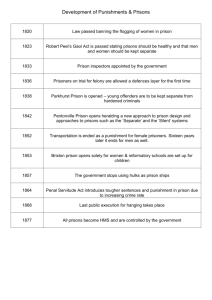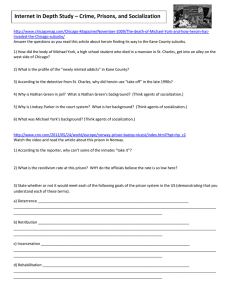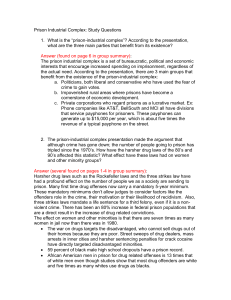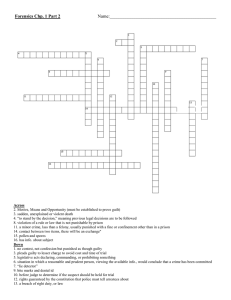Taylor Ms. Shimrock CJUS 335 8 May 2007
advertisement
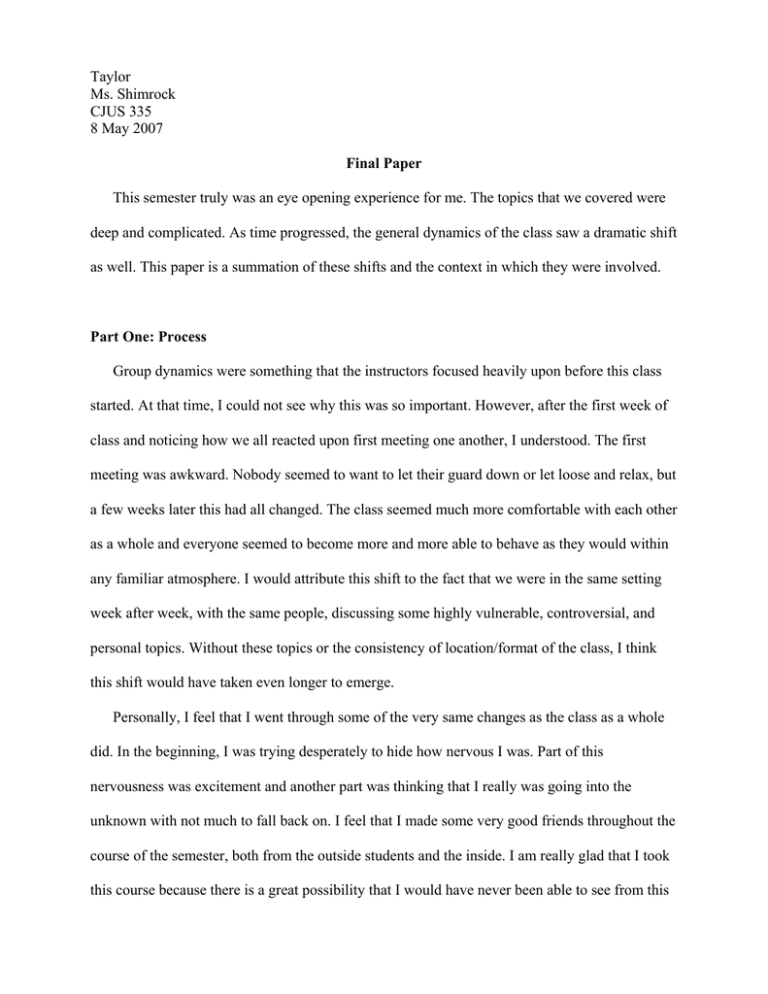
Taylor Ms. Shimrock CJUS 335 8 May 2007 Final Paper This semester truly was an eye opening experience for me. The topics that we covered were deep and complicated. As time progressed, the general dynamics of the class saw a dramatic shift as well. This paper is a summation of these shifts and the context in which they were involved. Part One: Process Group dynamics were something that the instructors focused heavily upon before this class started. At that time, I could not see why this was so important. However, after the first week of class and noticing how we all reacted upon first meeting one another, I understood. The first meeting was awkward. Nobody seemed to want to let their guard down or let loose and relax, but a few weeks later this had all changed. The class seemed much more comfortable with each other as a whole and everyone seemed to become more and more able to behave as they would within any familiar atmosphere. I would attribute this shift to the fact that we were in the same setting week after week, with the same people, discussing some highly vulnerable, controversial, and personal topics. Without these topics or the consistency of location/format of the class, I think this shift would have taken even longer to emerge. Personally, I feel that I went through some of the very same changes as the class as a whole did. In the beginning, I was trying desperately to hide how nervous I was. Part of this nervousness was excitement and another part was thinking that I really was going into the unknown with not much to fall back on. I feel that I made some very good friends throughout the course of the semester, both from the outside students and the inside. I am really glad that I took this course because there is a great possibility that I would have never been able to see from this perspective otherwise. I will always cherish what I learned from all of my classmates both in a professional and a personal way. I really didn’t know what to expect at first. I do remember that on the first day of class, I was trying to go around the room and pick out who I would get along with the most, who was most like me, who did what and other questions of this nature. From a retrospective point of view, I can say that I was completely wrong about all of my assumptions. Brandon was nowhere near the intimidating person that I thought him to be and Justin wasn’t the inexperienced youth that I originally perceived him to be. This is what really taught me to not judge a book by its cover because I could have missed getting to know some really interesting people. As far as prison life itself goes, I think that my assumptions were basically correct. I feel that from all of my criminal justice classes, books I’ve read, and the depiction of prison on television, I was able to conjure an accurate image of life in prison. If anything, I thought it would be much worse than it is. I was unaware of some of the luxuries offered in prisons and before this experience I would have condemned any and all of these luxuries. Now, I can see the need for them for the mental health of those incarcerated and I no longer view all prisoners as animals that need to be tied up. Granted, some inmates are animals, but this is not a generalization that should be applied to all. Part Two: Content All of the topics we discussed this semester are very ambiguous when it comes to having an answer. However, there is no shortage of stances on these topics. The very first thing we ever discussed as a class is what prisons are actually for. Answers to this question varied greatly, most likely as a result of teachings during upbringing or experiences in life. There is no real answer to this question. Prisons will always serve a different purpose based upon the person being asked the question. This is one of the central questions that lead to the vast ambiguity of the criminal justice system as a whole. I do believe that if this question was asked at the end of the semester as well, answers just might change a little bit. In addition to the difficulty in answering what prisons are for is the difficult question of why people commit crime. There are a number of theories as to why some offenders become offenders; environment, biological predisposition, anatomical throwbacks, life course theory, and others. However, the one thing that none of these theories can deny is that which is the essence of the human being: rationality. Basically, people commit crime because they choose to. They make a conscious choice to do wrong and follow through with that choice. It is all about influences and morals as “children growing up in these circumstances [poverty]…learn early in life…the way things are and the lessons of those who might teach them otherwise become less and less relevant,” and these children make a choice, although not a very informed one usually, and commit crime either as a juvenile or an adult (Anderson 134). Once these decisions are made and the crime committed, for whatever reason, those arrested can be sent to prison. Traditionally, prison life is not depicted as desirable or even manageable. One thing I never really thought about until the prison tour and reading Stanley “Tookie” Williams’ book was that in prison, “there is no privacy…there are no doors and no curtains,” and a life in prison is a life with few secrets (47). Part of the reason I never thought about this before was that I have never had to experience it before, but thinking about it, that is not the kind of life I could ever want. Being unable to hold anything back from anyone would be difficult to deal with. I don’t think I could ever make it and I admire prisoners for not going insane more often. The rest of what I imagine about prison was almost dead-on accurate and this lead me to realize one more thing about prison life; stereotypes exist for a reason. If there were not prisons in which the conditions actually were as depicted, they would not be depicted as such. One of the biggest issues that I see plaguing the criminal justice system is overcrowding of prisons and the speed with which the system is incarcerating individuals. Then, once incarcerated, the system rarely offers a reasonable chance to exit from the system. It is a vicious cycle that will continue to perpetuate until someone steps in and decides that enough is enough. My solution to this problem would be to take a more rehabilitative approach (where appropriate) to not only reduce the population in prisons, but to also give offenders a chance to get help and to move past offending. This would not be an easy task to accomplish, but I have faith that the right combination of punishment and rehabilitation is out there, it simply has not been found yet. I would like to see some crimes, drug crimes specifically, be handled in a more rehabilitative nature to begin with and for the first couple of offenses. Anything past two or three shows disregard for the law and punishment would be an order, but for those who truly do want to change, and I believe these people are out there, I think we need to give them a reasonable opportunity to do so. Drug courts are proving to be highly beneficial both financially and with regard to results, so I would like to see these used more. Maybe I am just naïve, but I think people can be helped and it is the responsibility of all those around that person to help out and make for a better society, whether that is before ever sending someone to prison or by helping them to re-integrate into society afterward (as mentioned in our group project). In conclusion, I still see many problems with the criminal justice system as a whole and many of my questions are left unanswered. Rather than let all of this perplex me, I plan to move on from this class and seek answers to the questions I most want answered. This class has served as a fantastic beginning for where my career will go and I will forever value what I have learned here and the people that I have been fortunate enough to encounter and learn from.


